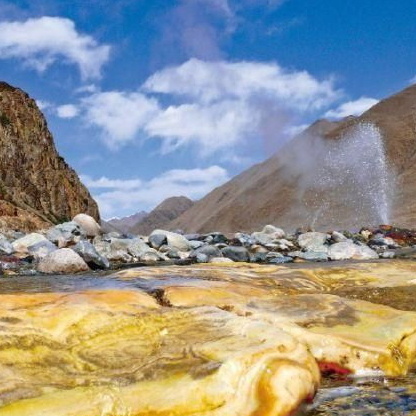
17 Lyrics
| Song | 17 |
| Artist | 英语听力 |
| Album | BBC美丽中国:走进西藏 |
| Download | Image LRC TXT |
| The possibility of escaping the cycle of life and death and the promise of enlightenment encourages people to perform activities that benefit all beings. This belief assigns as much importance to the environment and its creatures as it does to humans, since every living creature is believed to have a soul. In the remote lands of Tibet, for over 1,000 years this concept has been translated into practical benefits for wildlife, and it starts literally on their doorstep. | |
| Buddhist monasteries have sacred sites, areas where taboos are placed on the hunting and killing of animals. | |
| Some creatures have become so tame that the nuns are able to hand-feed them, like these Tibetan-eared pheasants. | |
| Thanks to hand-outs from the nuns,these rare birds can survive the worst of the winter. | |
| In this extreme place, people with few resources are prepared to share them with their needy fellow-creatures. The Tibetan example is a model for conservation. | |
| 摆脱生死轮回追求教化的想法,驱使着人们一心向善。由于相信万物都有灵魂 所以他们认为环境生物和人类都是平等的。一千多年以来 在西藏这偏僻的地方,这个观念为野生动植物带来了实实在在的好处。僧庙的佛教徒有一些神圣的地方,在那里猎杀动物是犯忌讳的,一些动物已经被驯服 喇嘛们都可以用手喂它们。比如西藏野鸡。由于喇嘛伸出援手 那些稀有的鸟们可以活过最寒冷的冬天。在这个极度严寒的地方 资源匮乏的人们,随时准备同需要帮助的生灵分享食物。西藏就是一个自然资源保护很好的例子 |
| The possibility of escaping the cycle of life and death and the promise of enlightenment encourages people to perform activities that benefit all beings. This belief assigns as much importance to the environment and its creatures as it does to humans, since every living creature is believed to have a soul. In the remote lands of Tibet, for over 1, 000 years this concept has been translated into practical benefits for wildlife, and it starts literally on their doorstep. | |
| Buddhist monasteries have sacred sites, areas where taboos are placed on the hunting and killing of animals. | |
| Some creatures have become so tame that the nuns are able to handfeed them, like these Tibetaneared pheasants. | |
| Thanks to handouts from the nuns, these rare birds can survive the worst of the winter. | |
| In this extreme place, people with few resources are prepared to share them with their needy fellowcreatures. The Tibetan example is a model for conservation. | |
| bai tuo sheng si lun hui zhui qiu jiao hua de xiang fa, qu shi zhe ren men yi xin xiang shan. you yu xiang xin wan wu dou you ling hun suo yi ta men ren wei huan jing sheng wu he ren lei dou shi ping deng de. yi qian duo nian yi lai zai xi zang zhe pian pi de di fang, zhe ge guan nian wei ye sheng dong zhi wu dai lai le shi shi zai zai de hao chu. seng miao de fo jiao tu you yi xie shen sheng de di fang, zai na li lie sha dong wu shi fan ji hui de, yi xie dong wu yi jing bei xun fu la ma men dou ke yi yong shou wei ta men. bi ru xi zang ye ji. you yu la ma shen chu yuan shou nei xie xi you de niao men ke yi huo guo zui han leng de dong tian. zai zhe ge ji du yan han de di fang zi yuan kui fa de ren men, sui shi zhun bei tong xu yao bang zhu de sheng ling fen xiang shi wu. xi zang jiu shi yi ge zi ran zi yuan bao hu hen hao de li zi |
| The possibility of escaping the cycle of life and death and the promise of enlightenment encourages people to perform activities that benefit all beings. This belief assigns as much importance to the environment and its creatures as it does to humans, since every living creature is believed to have a soul. In the remote lands of Tibet, for over 1, 000 years this concept has been translated into practical benefits for wildlife, and it starts literally on their doorstep. | |
| Buddhist monasteries have sacred sites, areas where taboos are placed on the hunting and killing of animals. | |
| Some creatures have become so tame that the nuns are able to handfeed them, like these Tibetaneared pheasants. | |
| Thanks to handouts from the nuns, these rare birds can survive the worst of the winter. | |
| In this extreme place, people with few resources are prepared to share them with their needy fellowcreatures. The Tibetan example is a model for conservation. | |
| bǎi tuō shēng sǐ lún huí zhuī qiú jiào huà de xiǎng fǎ, qū shǐ zhe rén men yī xīn xiàng shàn. yóu yú xiāng xìn wàn wù dōu yǒu líng hún suǒ yǐ tā men rèn wéi huán jìng shēng wù hé rén lèi dōu shì píng děng de. yī qiān duō nián yǐ lái zài xī zàng zhè piān pì de dì fāng, zhè gè guān niàn wèi yě shēng dòng zhí wù dài lái le shí shí zài zài de hǎo chù. sēng miào de fó jiào tú yǒu yī xiē shén shèng de dì fāng, zài nà li liè shā dòng wù shì fàn jì huì de, yī xiē dòng wù yǐ jīng bèi xún fú lǎ ma men dōu kě yǐ yòng shǒu wèi tā men. bǐ rú xī zàng yě jī. yóu yú lǎ ma shēn chū yuán shǒu nèi xiē xī yǒu de niǎo men kě yǐ huó guò zuì hán lěng de dōng tiān. zài zhè gè jí dù yán hán de dì fāng zī yuán kuì fá de rén men, suí shí zhǔn bèi tóng xū yào bāng zhù de shēng líng fēn xiǎng shí wù. xī zàng jiù shì yí gè zì rán zī yuán bǎo hù hěn hǎo de lì zi |
YouTube Results (More on YouTube)